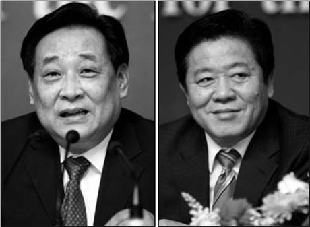
Zhang Lijun, left, is vice-minister of environmental protection. Zhao Hualin is director of the ministry's pollution prevention department.
A senior environmental official said China should consider capping coal consumption in Yangtze River Delta, Pearl River Delta and the Beijing-Tianjin-Hebei area, amid growing environmental pressures caused by rapid economic growth.
 |
|
Zhang Lijun, left, is vice-minister of environmental protection. Zhao Hualin is director of the ministry's pollution prevention department. |
China still faces grave cases of pollution despite the progress in cutting pollutants made during the past five years, Zhang Lijun, vice-minister of environmental protection, told a press conference during the national parliamentary session in Beijing on Saturday.
"In some regions, emissions of traditional water and air pollutants still remain higher than the environment can accommodate," Zhang said.
"Meanwhile, the country is faced with new challenges from soil pollution, hazardous waste and electronic waste. Such pollution poses even greater threats to human health," said Zhang.
Zhao Hualin, director of the ministry's pollution prevention department, said the country has set mandatory targets to reduce sulfur dioxide, a major cause of acid rain, and chemical oxygen demand, a measurement for water pollution, by 8 percent from 2010 levels during the next five years.
And emissions of nitrogen oxides (NOx), which comes from combustion of fossil fuels and damages people's respiratory systems, and ammonia nitrogen, which leads to excessive food sources for bacteria in water bodies, will be slashed by 10 percent from 2010 levels in the same period.
Zhang admitted curbing NOx emissions represented the biggest challenge, citing concerns over the country's expanding appetite for coal consumption and the rapid increase in car ownership in big cities.
"Between 2006 and 2010, coal consumption increased by about 1 billion tons. And it is likely to see another 1-billion-ton rise in the coming five years," said Zhang.
Coal remains the country's prime energy source, accounting for up to 70 percent of the energy mix. In 2010, China used 3.25 billion tons of standard coal equivalent.
Nitrogen emissions from vehicles added to the difficulties in curbing pollution, according to Zhang Lijun, who suggested imposing restrictions on car ownership in big cities with populations larger than 10 million.
The craze for economic growth among local governments also poses challenges for China's environment. Moreover, the anticipated rapid urbanization over the next five years will also push the country to seek greener growth, according to Zhang.
"Striking a balance between economic growth and environmental protection is the responsibility of governments at all levels," Zhang said, adding that local officials will be reviewed for both the growth rate in their regions and their efforts to protect the environment and public health.
Between 2006 and 2010, China reduced sulfur dioxide emissions by 14.29 percent and chemical oxygen demand by 12.45 percent from 2005 levels.
主站蜘蛛池模板: 91色在线观看| 天天天天做夜夜夜做| 国产无遮挡又黄又爽在线观看| 久久久久久久久久久久久久久久久久 | 精品一区二区三区无码免费视频| 成年人在线视频网站| 又湿又紧又大又爽a视频| 18女人腿打开无遮挡软| 成人福利小视频| 久久国产精品一国产精品| 毛片亚洲AV无码精品国产午夜 | 国产一区二区三区不卡av| 91在线亚洲综合在线| 成人永久福利在线观看不卡| 久久成人免费电影| 欧美综合婷婷欧美综合五月| 国产99久久精品一区二区| caopon国产在线视频| 女人体1963毛片a级| 久久国产成人精品| 欧美精品va在线观看| 伊人久久大香线蕉亚洲五月天 | 91精品国产高清久久久久| 成黄色激情视频网站| 久久久精品国产sm最大网站| 欧美性最猛xxxx在线观看视频| 午夜精品久久久久久| 高清欧美一区二区免费影视| 国产麻豆媒一区一区二区三区| 中文精品久久久久国产网址| 欧美国产激情二区三区| 免费福利小视频| 边吃奶边插下面| 国产精品免费视频网站| www.国产成人| 新婚熄与翁公老张林莹莹| 亚洲av无码不卡在线播放| 渣男渣女抹胸渣男渣女| 可以看的黄色国产毛片在线电影| 黑人粗长大战亚洲女2021国产精品成人免费视频| 在线欧美精品国产综合五月|